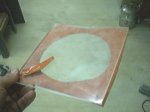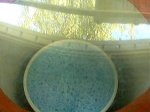A RTV Split Mold for Injecting Wax By Ray Brandes
Ray Brandes has put together a most excellent example on creating a RTV Split mold (2 part). Ray has other great examples on his web site and a nice air driven vibrator you can buy or download the plans and build yourself. Check him out at http://www.ray-vin.com/frfoundry.htm
Lost wax casting consumes the wax pattern each time you make a part. If you need to make any quantity of the same part, it is most efficient to make your wax patterns by molding. Wax can be injection molded like plastic into metal molds, but because of the lower temperatures involved, rubber molds are quite common and the injection apparatus can be very simple.
Here is how I make a RTV (Room Temperature Vulcanizing) silicone mold from a master pattern.
Caution: All technical data in this document reflect the limited experience of individuals using tools and materials over which the Ray-Vin has no control. Ray-Vin, its agents, officers, and employees accept no responsibility for the results obtained by persons using such data and disclaim all liability for any consequential injuries or damages.
 |
STEP 1 What you will need:
|
 |
STEP 2 Pack half of your flask with clay. |
 |
STEP 3 Embed your sprued model half way into the clay. |
 |
STEP 4 Carefully mold the clay to the pattern as close to the parting line as possible. Make sure there are no voids between the clay and the pattern. Then put in some dimples to act as keys to align the two halves. |
 |
STEP 5 Make a thin syrup mixture of petroleum jelly and naphtha. Lightly brush this onto the pattern and anything else you don't want the silicone to stick to. This also washes any small smears of clay off the pattern that may be above the parting line. |
 |
STEP 6 Close the flask. Here is a view into the closed flask. |
  |
STEP 7 Make a clay gasket for the bottom of the flask. Press the bottom seal against a bottom board. This will keep the silicone from leaking out the bottom of the flask, so make it tight. |
 |
STEP 8 Roll some clay out flat and make a top dam and fit it tightly to the top of the flask. You will need to slightly overfill the flask and you will need some room for expansion when you apply the vacuum to remove trapped air. |
  |
STEP 9 Have a vacuum chamber ready. It should be of sufficient size to hold your mixing container and the flask, though not at the same time. Get a length of 6" PVC pipe and smooth both ends. Put a fitting in the side for your vacuum pump hook up. Make two rubber gaskets. I use an iron plate on the bottom and a 1/4" thick piece of Lexan on the top. A pressure cooker will work, but you cannot see inside. Make your lid from a piece of 1/4" lexan. Attach a rubber gasket with sheet metal screws at the corners (outside the seal circle). A reed valve from scrap rubber covers a bleeder hole. To release the vacuum just lift the flap. |
 |
STEP 10 I calculate the volume that needs to be filled and then mark a line on a recycled food container. You want to use a big container. The green mark on the container is the liquid level. When vacuumed, the suds went right to the brim. If you are in doubt, use some wide tape to make it taller. |
 |
STEP 11 I use an electric drill with a little paint mixer to mix the components. The silicone is thick and white and very much like marshmallow fluff. The catalyst is blue and this helps you judge when you have mixed enough. I will usually stir it for about five minutes. |
  |
STEP 12 Put the mixed rubber into the vacuum chamber where a strong vacuum (at least 29 inches of Hg) is pulled. This is to remove trapped air. The air bubbles expand under vacuum to hundreds of times in size and rise to the surface where they break. This generally happens all at once since the vacuum turns the mix into foam. The whole thing expands and rises up in the cup. At some point all the bubbles seem to burst at once and the foam mass collapses. On the left is the rise just after it broke and on the right is the completed fall. It is difficult to see through the lexan. At this point most of the trapped air is out. If you think your mix is going to overflow, kill the vacuum and build up a skirt with wide tape on top of the mixing cup. |
 |
STEP 13 Take the mixed and de-gassed silicone from the vacuum chamber and carefully pour it down the side of the flask cavity. Over fill up into the clay dam area by about 1/4". |
 |
STEP 14 Close the flask inside the vacuum chamber and draw a vacuum on it. It should not rise and fall, but vacuum for about 10 minutes to pull out any trapped air bubbles. An air bubble against your pattern will be a metal bubble on your finished casting! |
 |
STEP 15 Patience! Now you just let it cure. I have found 24 hours to be enough to handle the rubber and proceed to the next step. The rubber will continue to cure and will reach full strength in several days. |
 |
STEP 16 When the rubber is fully cured (test the remnant in the mixing cup) it is safe to open the mold. In spite of the mold release it will still be tight, so be gentle! |
 |
STEP 17 Remove the clay and clean any clay off the silicone and the pattern. Put the rubber back in its half of the flask and fit the pattern into it. In patterns that are symmetrical about the parting line, you still have to be careful to get the same side of the pattern into the rubber as was originally cast. Brush up with petroleum & naptha and close the mold. |
 |
STEP 18 Here is the view into the closed mold. Now repeat steps 7 through 15. |
 |
STEP 19 Remove the rubber from the mold. Here is the rubber fresh from the mold after the second half is cast. |
 |
STEP 20 Separate the two halves. |
 |
STEP 21 With a sharp blade trim the excess rubber from the mold base. |
 |
STEP 22 Trim the excess rubber from the top. |
  |
STEP 23 Here is the finished mold halves on the top. |
 |
STEP 24 This is a simple wax injector. You can get these from jewelry supply houses. On the right is the mold all ready for the wax. |
 |
STEP 25 Wax is like metal and all the rules of solidification apply. |
 |
STEP 26 Open the mold after allowing a few minutes for the wax to cool. |
 |
STEP 27 Patterns-a-plenty! |
